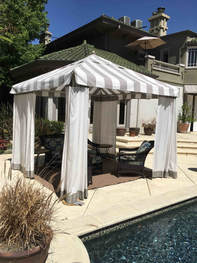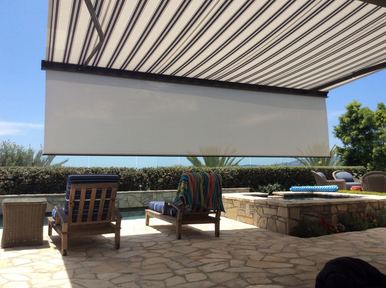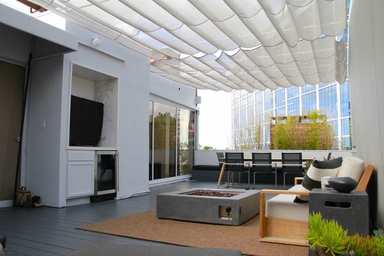Ultraviolet rays can be harmful and protecting yourself against them involves more than just putting on sunscreen or wearing long sleeves and hats. In fact, we often forget that UV rays not only effect human beings, but also objects and fabrics.
For homeowners and businesses, this translates into faded textiles and other fabric damage resulting from sunlight. That’s why when it comes to an awning, UV ray resistance is a must. But, what does this really mean?
For homeowners and businesses, this translates into faded textiles and other fabric damage resulting from sunlight. That’s why when it comes to an awning, UV ray resistance is a must. But, what does this really mean?
 Freestanding Cabana
Freestanding Cabana To begin with, awnings that are made with quality textiles are typically UV ray resistant. This means that not only does your awning provide shade and an extended outdoor area, it also provides protection for the interior of your home, your backyard furniture, and your family or patrons.
So, what does UV ray resistance mean? Technically, it means that the fabric is able to repel the sun’s harmful rays. This means that the fabric, like sunscreen, blocks out the UV rays that would normally come through. Your awning’s ability to repel those rays also means it’s fabric is strong and can last longer than things like basic cotton or canvas.
So, what does UV ray resistance mean? Technically, it means that the fabric is able to repel the sun’s harmful rays. This means that the fabric, like sunscreen, blocks out the UV rays that would normally come through. Your awning’s ability to repel those rays also means it’s fabric is strong and can last longer than things like basic cotton or canvas.
 Retractable Awning with a Retractable Valance
Retractable Awning with a Retractable Valance So, what should you look for when you’re thinking about installing or purchasing a UV ray resistant awning? Here’s a quick list:
· Quality of the Fabric: Make sure you find an installer that understand the different types of textiles available and that you get the one that fits your needs and includes UV ray resistance.
· Color: Think about the color your going to use and ask your installer if using opaque or other neutral colors is okay when it comes to UV ray resistance. (Typically, well-made opaque fabrics are UV ray resistant).
· Warranty: Make sure your fabric has a warranty.
· Strength/Tear Resistance: Make sure your fabric is strong and tear resistant. Holes and other tears can let sunlight through and UV rays.
· Quality of the Fabric: Make sure you find an installer that understand the different types of textiles available and that you get the one that fits your needs and includes UV ray resistance.
· Color: Think about the color your going to use and ask your installer if using opaque or other neutral colors is okay when it comes to UV ray resistance. (Typically, well-made opaque fabrics are UV ray resistant).
· Warranty: Make sure your fabric has a warranty.
· Strength/Tear Resistance: Make sure your fabric is strong and tear resistant. Holes and other tears can let sunlight through and UV rays.
Remember, always inspect your awning to be sure there is no damage, rips, tears, or other problems like fading. Also, keep in mind that you can always talk to your local professional awning installer about your awning and what features – like UV ray resistance – you should have when it comes to installing a shade structure.
Now that you know a little more about UV ray resistance and your awning, talk to your local professional about installing one today. For more information about awnings, feel free to contact us at American Awning & Blind Co. by visiting us at http://americanawningabc.com. Or call us at 800-654-5933. You can also email us at info@americanawningabc.com.
Now that you know a little more about UV ray resistance and your awning, talk to your local professional about installing one today. For more information about awnings, feel free to contact us at American Awning & Blind Co. by visiting us at http://americanawningabc.com. Or call us at 800-654-5933. You can also email us at info@americanawningabc.com.

